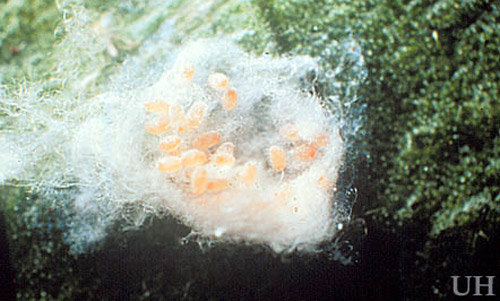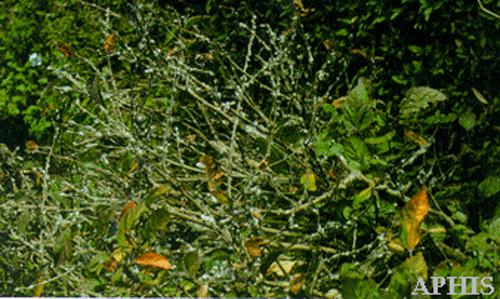common name: pink hibiscus mealybug
scientific name: Maconellicoccus hirsutus (Green) (Insecta: Hemiptera: Pseudococcidae)
Introduction - Distribution - Description and Life Cycle - Damage - Biological Control - Selected References
Introduction (Back to Top)
The pink hibiscus mealybug, Maconellicoccus hirsutus, is a serious pest of many plants in tropical and subtropical regions, including Africa, southeast Asia, and northern Australia. It was found in the Caribbean in 1994 for the first time. It was discovered in Broward County, Florida on 13 June, 2002, then in Dade County, and has continued to spread.
This pest has two common names (pink mealybug and hibiscus mealybug), but there is an effort to standardize the common name by calling the pest "pink hibiscus mealybug," even though it attacks many plant species, including citrus.
Figure 1. Various stages in the life cycle of the pink hibiscus mealybug, Maconellicoccus hirsutus (Green). Photograph by Dale Meyerdirk, APHIS.
The pink hibiscus mealybug is expected to attack many Florida crops including citrus, avocado, carambola, fig, guava, mango, soursop, and sugarcane; vegetable crops including asparagus, beans, beets, cabbage, peanuts, pigeon pea, cucumber, lettuce, pepper, pumpkin, and tomato; forest trees, and many species of ornamental plants including Allamanda, Angelica, Anthurium, Bougainvillea, Croton, ginger lily, Heliconia, Ixora, hibiscus, palm, and oleander.
Crop production costs will be increased if growers attempt to manage mealybug populations by pesticide applications. Pesticide applications will disrupt the effective natural enemies of other crop pests, such as mites, scale insects, and whiteflies leading to the application of additional pesticides to control these
pests. These additional pesticide applications can contaminate food, water and farm workers. Around the yard and home, insecticide use may also increase due to damage to ornamental plants, particularly hibiscus.
Distribution (Back to Top)
In the 1990s, Maconellicoccus hirsutus invaded several islands in the Caribbean: Grenada, St. Kitts, Nevis, Trinidad, Tobago, and the U.S. Virgin Islands. Pink hibiscus mealybug is expected to colonize all of Florida and spread north into southern Georgia. Because pink hibiscus mealybug attacks so many crop and
ornamental plants, populations could become common on many plant species in Florida.
Description and Life Cycle (Back to Top)
Adult mealybugs are small (about 3 mm long) and pink in body color but covered with a waxy secretion. The waxy filaments are short and females are usually obscured by this white mealy wax. When adults are crushed their body fluids are also pink. Adult males are smaller than females, reddish brown and have one pair of wings. Males have two long waxy "tails."

Figure 2. Freshly-laid eggs of the pink hibiscus mealybug, Maconellicoccus hirsutus (Green), are orange but become pink before they hatch. Photograph by Marshall Johnson, Department of Entomology, University of Hawaii at Manoa.

Figure 3. Adult female (arrow) and offspring of the pink hibiscus mealybug, Maconellicoccus hirsutus (Green). Photograph by Dale Meyerdirk, APHIS.

Figure 4. Adult male pink hibiscus mealybug, Maconellicoccus hirsutus (Green). Notice the two long waxy "tails”. Photograph by Marshall Johnson, Department of Entomology, University of Hawaii at Manoa.
Females die shortly after depositing eggs. Freshly-laid eggs are orange, becoming pink before they hatch. Eggs are found in egg sacs. First instar nymphs (crawlers) of the pink hibiscus mealybug disperse by walking and by wind. Nymphs also can walk considerable distances to find suitable host plants. The life cycle takes about 23 to 30 days. The pink hibiscus mealybug has a high reproductive rate (females can deposit up to 600 eggs) and produces up to 15 generations per year, so pest populations can become very large.
Pink hibiscus mealybug eggs overwinter in bark crevices, leaf scars, under bark, in the soil, tree boles, inside fruit clusters, and inside crumpled leaf clusters.
Damage (Back to Top)
The pink hibiscus mealybug is not just an agricultural problem. This pest will attack ornamental plants in yards and parks.
Figure 5. Hibiscus twig infested by pink hibiscus mealybug, Maconellicoccus hirsutus (Green). Photograph by Dale Meyerdirk, APHIS.
Figure 6. Hibiscus shrub heavily infested by pink hibiscus mealybug, Maconellicoccus hirsutus (Green). Photograph by Dale Meyerdirk, APHIS.
Figure 7. Feeding on soft tissues of citrus by the pink hibiscus mealybug, Maconellicoccus hirsutus (Green), results in deformed leaves and shoots or "bunchy top." Fruit also may be deformed. Photograph by Dale Meyerdirk, APHIS.
Pink hibiscus mealybug feeds on the soft tissues of many plant species and injects a toxic saliva that causes curling and contortion of leaves. The entire plant may be stunted and the shoot tips develop a bushy appearance. Buds may not flower and stems may twist. Fruit may also be deformed. The mealybug excretes honeydew which encourages the development of black sooty mold. Very high mealybug populations can kill plants.
The level of feeding damage depends on the vigor of the infested plant; seedling trees and weakened trees are more susceptible. Shoots become twisted with shortened internodes, forming bunchy heads of small bushy leaves at the tips. The curled leaves can resemble viral damage, but this pest is not known to vector any diseases. Heavy infestations of young plants by the pink hibiscus mealybug may stunt their growth.
The mealybug is found on stems, leaves, buds, fruit and roots of many plants. On hibiscus, the mealybug usually infests young twigs, causing deformed terminal growth due to shortening of the internodes, deformed leaves and thickened twigs. In cotton, the growing parts are attacked, resulting in bunchy growth. Plants
are stunted and produce fewer bolls of a smaller size. Boll opening is adversely affected and yield reduction occurs. In grapevines, the mealybug feeds on sprouts after pruning; heavily infested bunches shrivel and drop. In peanut, the mealybug can feed on the underground parts of the roots, pods, and pegs of the plant, resulting in stunted growth and poorly developed pods.
Biological Control (Back to Top)
As the pink hibiscus mealybug spreads across Florida we will have to learn to live with this pest. Native natural enemies are expected to provide some control. We also believe this pest can be suppressed by the importation, rearing, release and establishment of host-specific natural enemies (classical biological control). Such natural enemies are known to exist and can provide substantial control.
The ladybug Cryptolaemus montrouzieri is known to feed on all stages of the mealybug. This beetle already is established in Florida and also is available commercially. The appropriate release rate for this ladybug is unknown. Predatory ladybugs may provide some suppression of high pest populations, but are not expected to provide adequate control of lower populations because the beetles require large numbers of mealybugs to survive.
Figure 8. Predatory ladybugs, such as Cryptolaemus montrouzieri, may provide some suppression of high pink hibiscus mealybug, Maconellicoccus hirsutus (Green), pest populations, but are not expected to provide adequate control of lower populations because the beetles require large numbers of mealybugs to survive. Photograph by Lance Osborne, University of Florida.
Cryptolaemus larvae are covered with a white flocculent secretion and may be confused with pink hibiscus mealybugs but are important predators and should not be destroyed.
Figure 9. The ladybug Cryptolaemus larvae are covered with a white flocculent secretion and may be confused with pink hibiscus mealybugs but are important predators and should not be destroyed. Photograph by Lance Osborne, University of Florida.
The pink hibiscus mealybug is a good candidate for classical biological control. Several effective parasitoids are known in Asia and elsewhere. One parasitoid, Anagyrus kamali, completes a generation in less than half the time required for its host. Anagyrus kamali has been reported to be an outstanding natural enemy in Egypt and Hawaii and is able to dramatically suppress pink hibiscus mealybug populations. This parasitoid has been released on islands in the Caribbean and appears to be providing substantial control already. Pink hibiscus mealybugs parasitized by A. kamali produce "mummies" and have an exit hole where the adult wasp emerges.
Figure 10. Two pink hibiscus mealybug, Maconellicoccus hirsutus (Green), mummies (parasitized mealybugs). Note parasitoid exit hole on the bottom left mummy. Photograph by Marshall Johnson, Department of Entomology, University of Hawaii at Manoa.
Several other parasitoid species also are known to attack the pink hibiscus mealybug. These parasitoids will be evaluated for their host specificity and may be released when more is known about their biology.
Classical biological control projects often take several years to conduct. In order to shorten the time it will take to conduct a classical biological control program on the pink hibiscus mealybug, we have made contact with scientists in the native range of these pests for assistance in identifying sites where
natural enemies can be collected and we have obtained permits for importing these natural enemies into quarantine for evaluation. The USDA-APHIS also has agreed to provide starter cultures of parasitoids for evaluation, rearing, and release in Florida. Natural enemy species have been identified for which a
substantial amount of information is available, which means that permission to get these species out of quarantine for mass rearing and release in Florida will be expedited once we know the pest is here in Florida.
Selected References (Back to Top)
- Beardsley JW. 1985. Notes and exhibitions. Anagyrus kamali Moursi and Anagyrus sp. Proceedings of the Hawaiian Entomological Society 25: 27-28.
- Ghose SK. 1972. Biology of the mealybug, Maconellicoccus hirsutus. Indian Agriculture 16: 323-332.
- Hall WJ. 1921. The hibiscus mealybug. Ministry of Agriculture, Egypt, Technical Science Series, Entomology Section Bulletin 17: 1-28.
- Hall WJ. 1921. The hibiscus mealybug in Egypt in 1925 with notes on the introduction of Cryptolaemus montrouzieri. Ministry of Agriculture, Egypt. Technical Science Series, Entomology Section Bulletin 70: 1-15.
- Kamal M. 1951. Biological control projects in Egypt, with a list of introduced parasites and predators. Bull. Societ. Fouad 1er d'Entomol. 35: 205-220.
- Mani M. 1989. A review of the pink mealybug-Maconellicoccus hirsutus (Green). Insect Science and its Application 10: 157-167.
- Matilé-Ferrero D, Etienne J. 1996. Presénce de la Cochenille de l'hibiscus, Maconellicoccus hirsutus á Saint-Martin (Hemiptera, Pseudococcidae). Revue Francaise d'Entomologie (N.S.) 18: 38.
- Moursi AA. 1948. Description of two new species of Anagyrus. Bull. Societ. Fouad 1er Entom. 32: 1-7.
- Moursi AA. 1948. Anagyrus kamali Moursi, a parasite of the hibiscus mealybug, Phenacoccus hirsutus Green. Bull. Societ. Fouad 1er Entom. 32: 9-16.
- Noyes JS, Hayat M. 1996. Oriental mealybug parasitoids of the Anagyrini (Hymenoptera:Eucyrtidae) CAB International, London.
- Rao VS, Srinivasan S. 1987. Maconellicoccus hirsutus, a new pest of groundnut in Andhra Pradesh. Entomon. 12: 115.
- USDA-APHIS. 1997. Field releases of nonindigenous species of Anagyrus and Gyranusoidea (Hymenoptera: Encyrtidae) for biological control of pink hibiscus mealybug, Maconellicoccus hirsutus (Homoptera: Pseudococcidae). Environmental Assessment. 8 pp.
- USDA-APHIS. 1997. Program Aid No. 1606. Look out for the pink hibiscus mealybug. 11 pp.
- USDA-APHIS. 1996. Pathway risk assessment. Pink Mealybug from the Caribbean. 61pp.
- Williams DJ. 1996. A brief account of the hibiscus mealybug Maconellicoccus hirsutus (Hemiptera: Pseudococcidae), a pest of agriculture and horticulture, with descriptions of two related species from southern Asia. Bulletin of Entomological Research. 86: 617-628.
